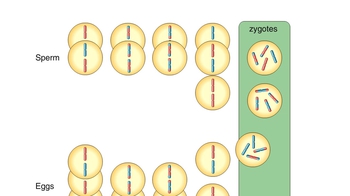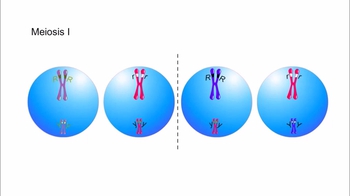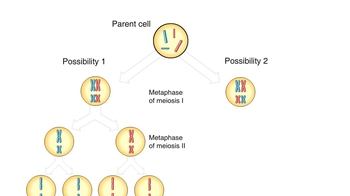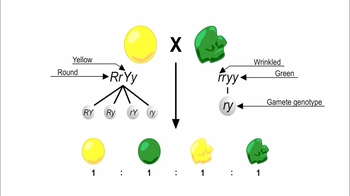Table of contents
- 1. Introduction to Biology2h 42m
- 2. Chemistry3h 40m
- 3. Water1h 26m
- 4. Biomolecules2h 23m
- 5. Cell Components2h 26m
- 6. The Membrane2h 31m
- 7. Energy and Metabolism2h 0m
- 8. Respiration2h 40m
- 9. Photosynthesis2h 49m
- 10. Cell Signaling59m
- 11. Cell Division2h 47m
- 12. Meiosis2h 0m
- 13. Mendelian Genetics4h 44m
- Introduction to Mendel's Experiments7m
- Genotype vs. Phenotype17m
- Punnett Squares13m
- Mendel's Experiments26m
- Mendel's Laws18m
- Monohybrid Crosses19m
- Test Crosses14m
- Dihybrid Crosses20m
- Punnett Square Probability26m
- Incomplete Dominance vs. Codominance20m
- Epistasis7m
- Non-Mendelian Genetics12m
- Pedigrees6m
- Autosomal Inheritance21m
- Sex-Linked Inheritance43m
- X-Inactivation9m
- 14. DNA Synthesis2h 27m
- 15. Gene Expression3h 20m
- 16. Regulation of Expression3h 31m
- Introduction to Regulation of Gene Expression13m
- Prokaryotic Gene Regulation via Operons27m
- The Lac Operon21m
- Glucose's Impact on Lac Operon25m
- The Trp Operon20m
- Review of the Lac Operon & Trp Operon11m
- Introduction to Eukaryotic Gene Regulation9m
- Eukaryotic Chromatin Modifications16m
- Eukaryotic Transcriptional Control22m
- Eukaryotic Post-Transcriptional Regulation28m
- Eukaryotic Post-Translational Regulation13m
- 17. Viruses37m
- 18. Biotechnology2h 58m
- 19. Genomics17m
- 20. Development1h 5m
- 21. Evolution3h 1m
- 22. Evolution of Populations3h 52m
- 23. Speciation1h 37m
- 24. History of Life on Earth2h 6m
- 25. Phylogeny2h 31m
- 26. Prokaryotes4h 59m
- 27. Protists1h 12m
- 28. Plants1h 22m
- 29. Fungi36m
- 30. Overview of Animals34m
- 31. Invertebrates1h 2m
- 32. Vertebrates50m
- 33. Plant Anatomy1h 3m
- 34. Vascular Plant Transport1h 2m
- 35. Soil37m
- 36. Plant Reproduction47m
- 37. Plant Sensation and Response1h 9m
- 38. Animal Form and Function1h 19m
- 39. Digestive System1h 10m
- 40. Circulatory System1h 57m
- 41. Immune System1h 12m
- 42. Osmoregulation and Excretion50m
- 43. Endocrine System1h 4m
- 44. Animal Reproduction1h 2m
- 45. Nervous System1h 55m
- 46. Sensory Systems46m
- 47. Muscle Systems23m
- 48. Ecology3h 11m
- Introduction to Ecology20m
- Biogeography14m
- Earth's Climate Patterns50m
- Introduction to Terrestrial Biomes10m
- Terrestrial Biomes: Near Equator13m
- Terrestrial Biomes: Temperate Regions10m
- Terrestrial Biomes: Northern Regions15m
- Introduction to Aquatic Biomes27m
- Freshwater Aquatic Biomes14m
- Marine Aquatic Biomes13m
- 49. Animal Behavior28m
- 50. Population Ecology3h 41m
- Introduction to Population Ecology28m
- Population Sampling Methods23m
- Life History12m
- Population Demography17m
- Factors Limiting Population Growth14m
- Introduction to Population Growth Models22m
- Linear Population Growth6m
- Exponential Population Growth29m
- Logistic Population Growth32m
- r/K Selection10m
- The Human Population22m
- 51. Community Ecology2h 46m
- Introduction to Community Ecology2m
- Introduction to Community Interactions9m
- Community Interactions: Competition (-/-)38m
- Community Interactions: Exploitation (+/-)23m
- Community Interactions: Mutualism (+/+) & Commensalism (+/0)9m
- Community Structure35m
- Community Dynamics26m
- Geographic Impact on Communities21m
- 52. Ecosystems2h 36m
- 53. Conservation Biology24m
12. Meiosis
Genetic Variation During Meiosis
Problem 13`
Textbook Question
Select True or False for each statement.
T/F Linked genes are always inherited together.
T/F Genetic map distances measure the number of nucleotides between a pair of genes.
T/F The farther apart genes are on a chromosome, the more likely there is to be a crossover between these genes during meiosis.
T/F Crossing over occurs between genes on different homologs of a homologous chromosome pair.
 Verified step by step guidance
Verified step by step guidance1
Understand the concept of linked genes: Linked genes are located close to each other on the same chromosome and tend to be inherited together because the likelihood of crossing over between them is low. However, they are not always inherited together due to possible recombination events.
Explore genetic map distances: Genetic map distances are measured in centimorgans (cM) and represent the frequency of recombination between genes, not the physical number of nucleotides. This distance is a measure of how often crossing over occurs between genes during meiosis.
Consider the relationship between gene distance and crossover frequency: The farther apart two genes are on a chromosome, the higher the probability of a crossover event occurring between them during meiosis. This is because there is more physical space for recombination to occur.
Examine the process of crossing over: Crossing over occurs during meiosis when homologous chromosomes exchange genetic material. This exchange happens between non-sister chromatids of homologous chromosome pairs, allowing for genetic variation.
Review each statement based on the explanations: Use the understanding of linked genes, genetic map distances, crossover frequency, and the process of crossing over to determine the truthfulness of each statement provided in the problem.
 Verified video answer for a similar problem:
Verified video answer for a similar problem:This video solution was recommended by our tutors as helpful for the problem above
Video duration:
3mPlay a video:
Was this helpful?
Key Concepts
Here are the essential concepts you must grasp in order to answer the question correctly.
Linked Genes
Linked genes are genes located close to each other on the same chromosome, which tend to be inherited together due to their physical proximity. However, they are not always inherited together because crossing over during meiosis can separate them, leading to genetic recombination.
Recommended video:
Guided course

Sex-Linked Inheritance
Genetic Map Distances
Genetic map distances are measured in centimorgans (cM) and represent the frequency of recombination between genes, not the physical distance in nucleotides. A higher recombination frequency indicates that genes are farther apart on the chromosome, allowing for more crossover events.
Recommended video:
Guided course

Genetic Code
Crossing Over
Crossing over is a process during meiosis where homologous chromosomes exchange genetic material, increasing genetic diversity. It occurs between non-sister chromatids of homologous chromosome pairs, and the likelihood of crossing over increases with the physical distance between genes on the chromosome.
Recommended video:
Guided course

Monohybrid Crosses

 7:08m
7:08mWatch next
Master Genetic Variation During Meiosis with a bite sized video explanation from Jason
Start learningRelated Videos
Related Practice















